Leadership Styles and Their Effect on Organizational Performance (MBA)
VerifiedAdded on 2021/09/18
|10
|3614
|35
Essay
AI Summary
This MBA assignment delves into the critical relationship between leadership and organizational performance. It defines leadership and its impact on achieving organizational goals. The essay explores various leadership styles, including servant leadership, characterized by serving others and fostering teamwork; laissez-faire or delegating leadership, where leaders provide minimal oversight; and transformational leadership, which focuses on the growth and needs of followers. The assignment examines how these styles influence employee motivation, decision-making, and overall organizational success, citing research and studies to support its findings. The paper highlights the significance of effective leadership in navigating challenges, promoting employee engagement, and achieving long-term economic benefits. The study emphasizes the importance of adapting leadership approaches to suit specific organizational contexts and the needs of employees, ultimately aiming to provide insights into how leaders can drive efficiency, encourage growth, and enhance organizational outcomes. The assignment also discusses the potential benefits and drawbacks of each leadership style, providing a comprehensive analysis of their effects on organizational performance.
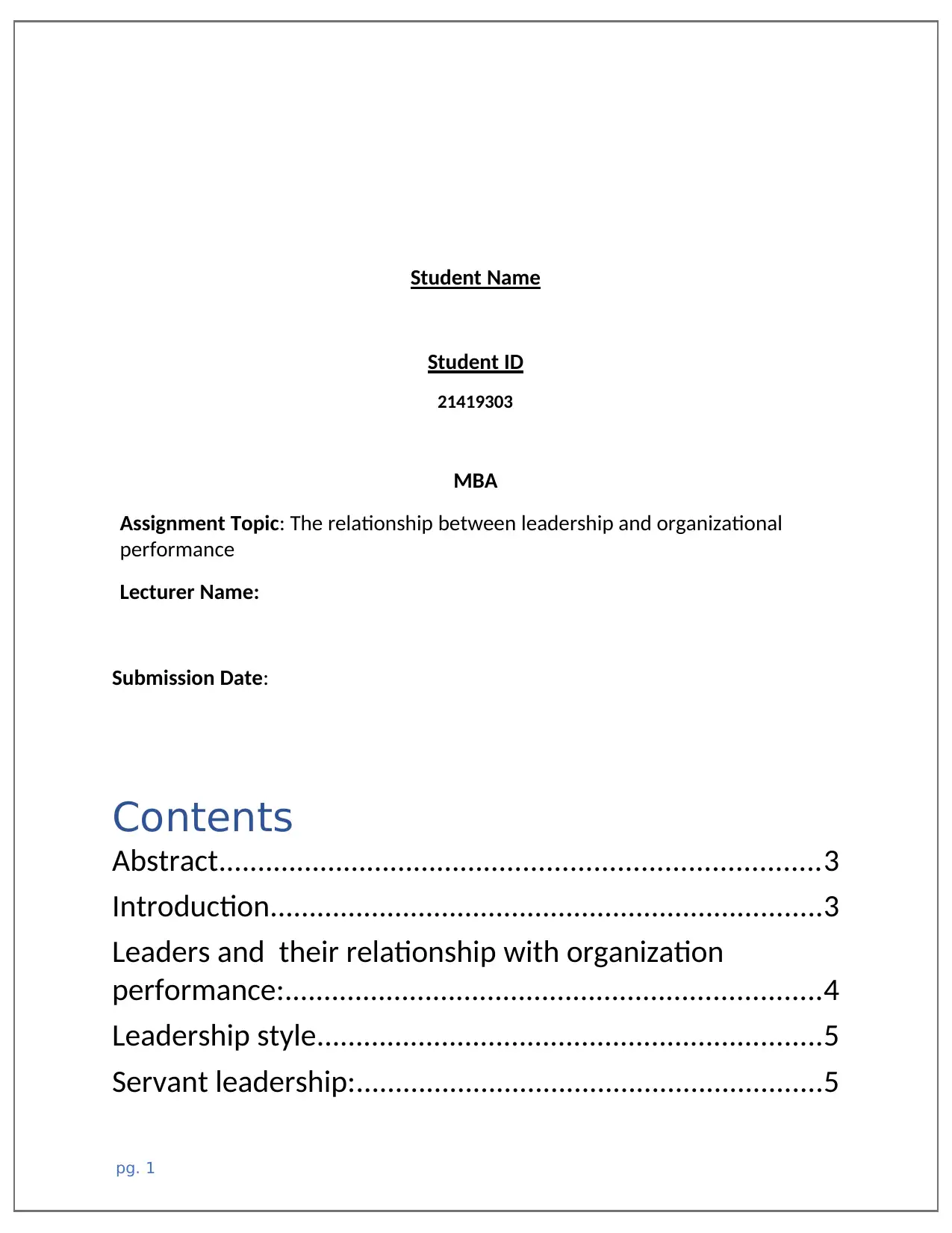
Student Name
Student ID
21419303
MBA
Assignment Topic: The relationship between leadership and organizational
performance
Lecturer Name:
Submission Date:
Contents
Abstract.............................................................................3
Introduction.......................................................................3
Leaders and their relationship with organization
performance:.....................................................................4
Leadership style.................................................................5
Servant leadership:............................................................5
pg. 1
Student ID
21419303
MBA
Assignment Topic: The relationship between leadership and organizational
performance
Lecturer Name:
Submission Date:
Contents
Abstract.............................................................................3
Introduction.......................................................................3
Leaders and their relationship with organization
performance:.....................................................................4
Leadership style.................................................................5
Servant leadership:............................................................5
pg. 1
Paraphrase This Document
Need a fresh take? Get an instant paraphrase of this document with our AI Paraphraser
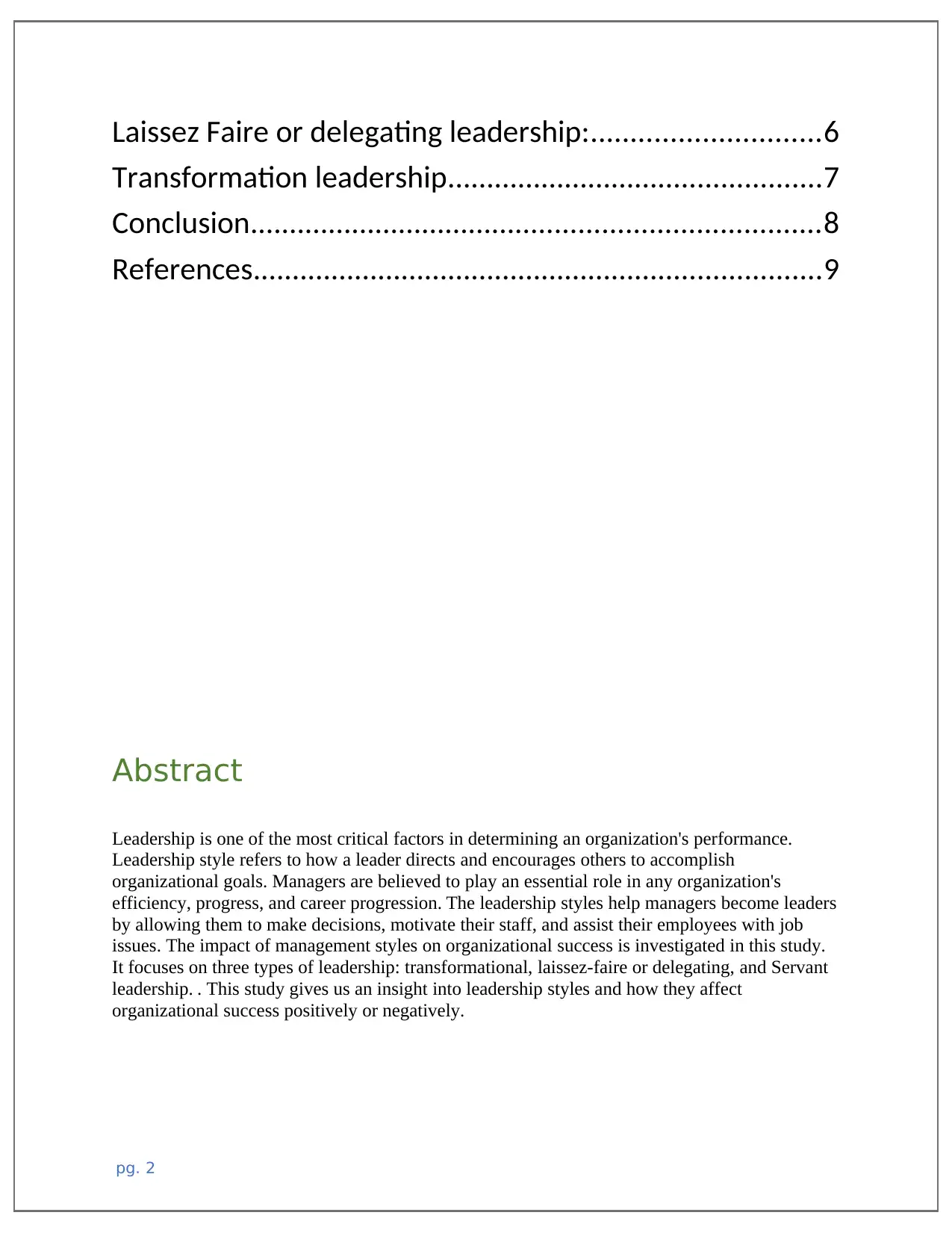
Laissez Faire or delegating leadership:.............................6
Transformation leadership................................................7
Conclusion.........................................................................8
References.........................................................................9
Abstract
Leadership is one of the most critical factors in determining an organization's performance.
Leadership style refers to how a leader directs and encourages others to accomplish
organizational goals. Managers are believed to play an essential role in any organization's
efficiency, progress, and career progression. The leadership styles help managers become leaders
by allowing them to make decisions, motivate their staff, and assist their employees with job
issues. The impact of management styles on organizational success is investigated in this study.
It focuses on three types of leadership: transformational, laissez-faire or delegating, and Servant
leadership. . This study gives us an insight into leadership styles and how they affect
organizational success positively or negatively.
pg. 2
Transformation leadership................................................7
Conclusion.........................................................................8
References.........................................................................9
Abstract
Leadership is one of the most critical factors in determining an organization's performance.
Leadership style refers to how a leader directs and encourages others to accomplish
organizational goals. Managers are believed to play an essential role in any organization's
efficiency, progress, and career progression. The leadership styles help managers become leaders
by allowing them to make decisions, motivate their staff, and assist their employees with job
issues. The impact of management styles on organizational success is investigated in this study.
It focuses on three types of leadership: transformational, laissez-faire or delegating, and Servant
leadership. . This study gives us an insight into leadership styles and how they affect
organizational success positively or negatively.
pg. 2
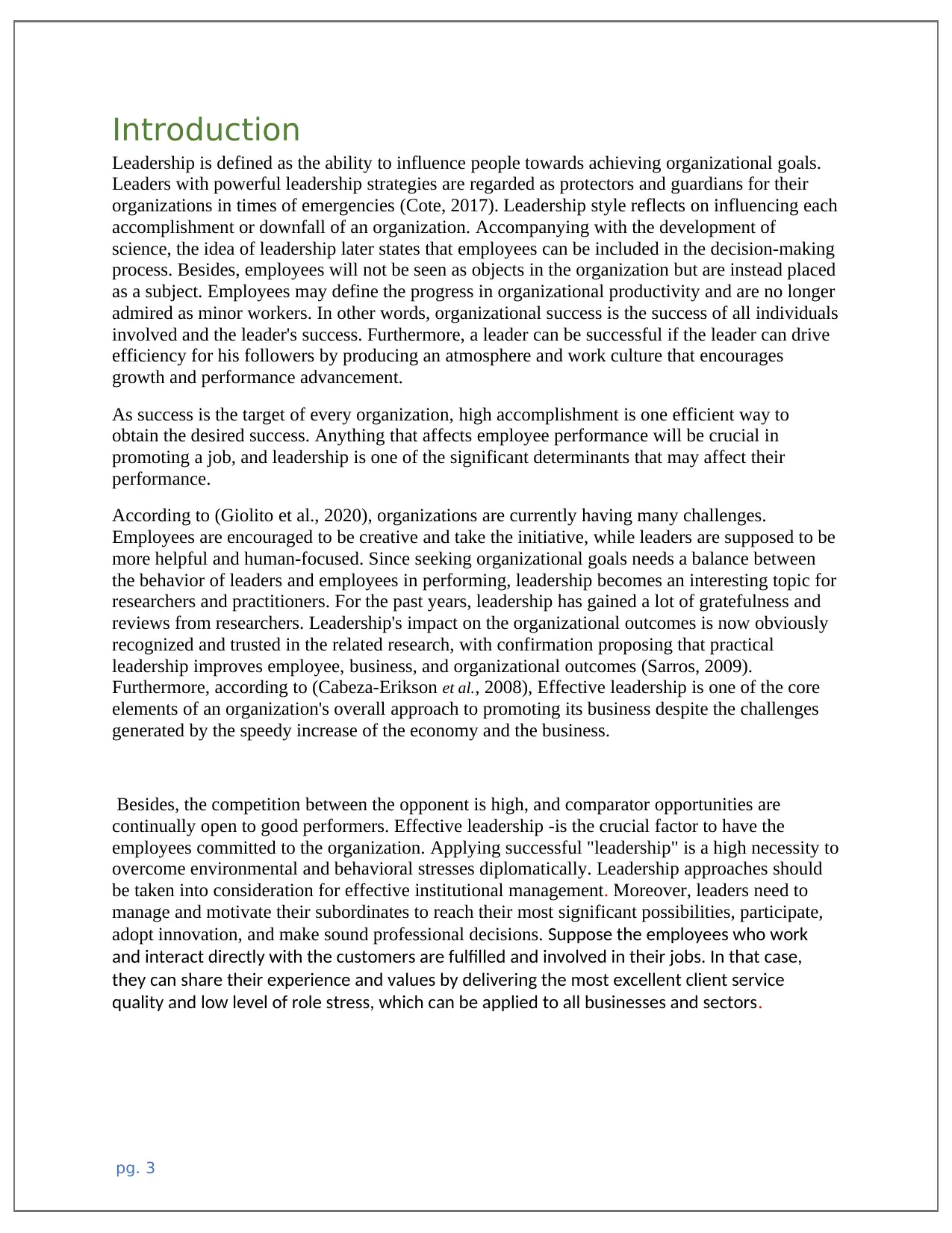
Introduction
Leadership is defined as the ability to influence people towards achieving organizational goals.
Leaders with powerful leadership strategies are regarded as protectors and guardians for their
organizations in times of emergencies (Cote, 2017). Leadership style reflects on influencing each
accomplishment or downfall of an organization. Accompanying with the development of
science, the idea of leadership later states that employees can be included in the decision-making
process. Besides, employees will not be seen as objects in the organization but are instead placed
as a subject. Employees may define the progress in organizational productivity and are no longer
admired as minor workers. In other words, organizational success is the success of all individuals
involved and the leader's success. Furthermore, a leader can be successful if the leader can drive
efficiency for his followers by producing an atmosphere and work culture that encourages
growth and performance advancement.
As success is the target of every organization, high accomplishment is one efficient way to
obtain the desired success. Anything that affects employee performance will be crucial in
promoting a job, and leadership is one of the significant determinants that may affect their
performance.
According to (Giolito et al., 2020), organizations are currently having many challenges.
Employees are encouraged to be creative and take the initiative, while leaders are supposed to be
more helpful and human-focused. Since seeking organizational goals needs a balance between
the behavior of leaders and employees in performing, leadership becomes an interesting topic for
researchers and practitioners. For the past years, leadership has gained a lot of gratefulness and
reviews from researchers. Leadership's impact on the organizational outcomes is now obviously
recognized and trusted in the related research, with confirmation proposing that practical
leadership improves employee, business, and organizational outcomes (Sarros, 2009).
Furthermore, according to (Cabeza-Erikson et al., 2008), Effective leadership is one of the core
elements of an organization's overall approach to promoting its business despite the challenges
generated by the speedy increase of the economy and the business.
Besides, the competition between the opponent is high, and comparator opportunities are
continually open to good performers. Effective leadership -is the crucial factor to have the
employees committed to the organization. Applying successful "leadership" is a high necessity to
overcome environmental and behavioral stresses diplomatically. Leadership approaches should
be taken into consideration for effective institutional management. Moreover, leaders need to
manage and motivate their subordinates to reach their most significant possibilities, participate,
adopt innovation, and make sound professional decisions. Suppose the employees who work
and interact directly with the customers are fulfilled and involved in their jobs. In that case,
they can share their experience and values by delivering the most excellent client service
quality and low level of role stress, which can be applied to all businesses and sectors.
pg. 3
Leadership is defined as the ability to influence people towards achieving organizational goals.
Leaders with powerful leadership strategies are regarded as protectors and guardians for their
organizations in times of emergencies (Cote, 2017). Leadership style reflects on influencing each
accomplishment or downfall of an organization. Accompanying with the development of
science, the idea of leadership later states that employees can be included in the decision-making
process. Besides, employees will not be seen as objects in the organization but are instead placed
as a subject. Employees may define the progress in organizational productivity and are no longer
admired as minor workers. In other words, organizational success is the success of all individuals
involved and the leader's success. Furthermore, a leader can be successful if the leader can drive
efficiency for his followers by producing an atmosphere and work culture that encourages
growth and performance advancement.
As success is the target of every organization, high accomplishment is one efficient way to
obtain the desired success. Anything that affects employee performance will be crucial in
promoting a job, and leadership is one of the significant determinants that may affect their
performance.
According to (Giolito et al., 2020), organizations are currently having many challenges.
Employees are encouraged to be creative and take the initiative, while leaders are supposed to be
more helpful and human-focused. Since seeking organizational goals needs a balance between
the behavior of leaders and employees in performing, leadership becomes an interesting topic for
researchers and practitioners. For the past years, leadership has gained a lot of gratefulness and
reviews from researchers. Leadership's impact on the organizational outcomes is now obviously
recognized and trusted in the related research, with confirmation proposing that practical
leadership improves employee, business, and organizational outcomes (Sarros, 2009).
Furthermore, according to (Cabeza-Erikson et al., 2008), Effective leadership is one of the core
elements of an organization's overall approach to promoting its business despite the challenges
generated by the speedy increase of the economy and the business.
Besides, the competition between the opponent is high, and comparator opportunities are
continually open to good performers. Effective leadership -is the crucial factor to have the
employees committed to the organization. Applying successful "leadership" is a high necessity to
overcome environmental and behavioral stresses diplomatically. Leadership approaches should
be taken into consideration for effective institutional management. Moreover, leaders need to
manage and motivate their subordinates to reach their most significant possibilities, participate,
adopt innovation, and make sound professional decisions. Suppose the employees who work
and interact directly with the customers are fulfilled and involved in their jobs. In that case,
they can share their experience and values by delivering the most excellent client service
quality and low level of role stress, which can be applied to all businesses and sectors.
pg. 3
⊘ This is a preview!⊘
Do you want full access?
Subscribe today to unlock all pages.

Trusted by 1+ million students worldwide
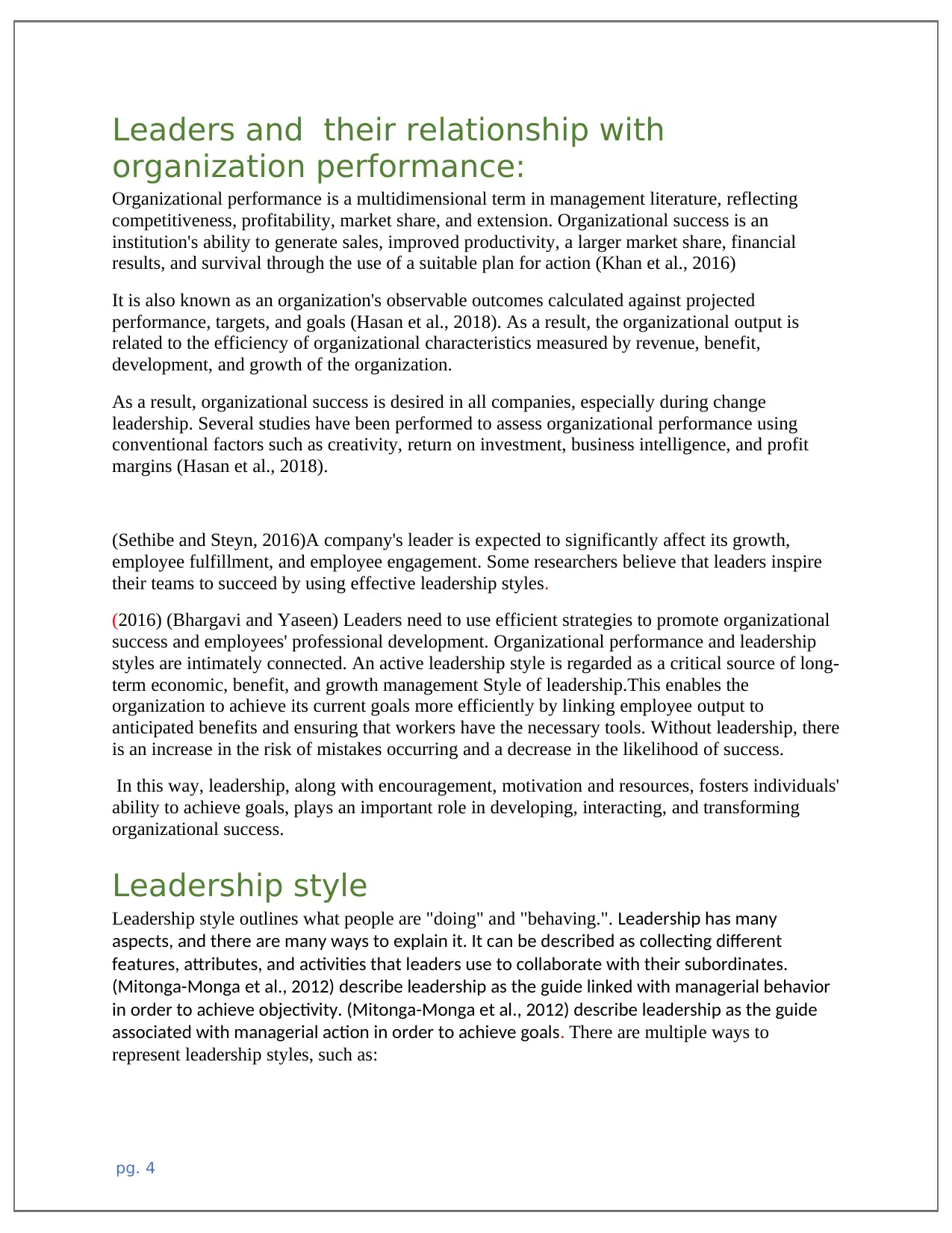
Leaders and their relationship with
organization performance:
Organizational performance is a multidimensional term in management literature, reflecting
competitiveness, profitability, market share, and extension. Organizational success is an
institution's ability to generate sales, improved productivity, a larger market share, financial
results, and survival through the use of a suitable plan for action (Khan et al., 2016)
It is also known as an organization's observable outcomes calculated against projected
performance, targets, and goals (Hasan et al., 2018). As a result, the organizational output is
related to the efficiency of organizational characteristics measured by revenue, benefit,
development, and growth of the organization.
As a result, organizational success is desired in all companies, especially during change
leadership. Several studies have been performed to assess organizational performance using
conventional factors such as creativity, return on investment, business intelligence, and profit
margins (Hasan et al., 2018).
(Sethibe and Steyn, 2016)A company's leader is expected to significantly affect its growth,
employee fulfillment, and employee engagement. Some researchers believe that leaders inspire
their teams to succeed by using effective leadership styles.
(2016) (Bhargavi and Yaseen) Leaders need to use efficient strategies to promote organizational
success and employees' professional development. Organizational performance and leadership
styles are intimately connected. An active leadership style is regarded as a critical source of long-
term economic, benefit, and growth management Style of leadership.This enables the
organization to achieve its current goals more efficiently by linking employee output to
anticipated benefits and ensuring that workers have the necessary tools. Without leadership, there
is an increase in the risk of mistakes occurring and a decrease in the likelihood of success.
In this way, leadership, along with encouragement, motivation and resources, fosters individuals'
ability to achieve goals, plays an important role in developing, interacting, and transforming
organizational success.
Leadership style
Leadership style outlines what people are "doing" and "behaving.". Leadership has many
aspects, and there are many ways to explain it. It can be described as collecting different
features, attributes, and activities that leaders use to collaborate with their subordinates.
(Mitonga-Monga et al., 2012) describe leadership as the guide linked with managerial behavior
in order to achieve objectivity. (Mitonga-Monga et al., 2012) describe leadership as the guide
associated with managerial action in order to achieve goals. There are multiple ways to
represent leadership styles, such as:
pg. 4
organization performance:
Organizational performance is a multidimensional term in management literature, reflecting
competitiveness, profitability, market share, and extension. Organizational success is an
institution's ability to generate sales, improved productivity, a larger market share, financial
results, and survival through the use of a suitable plan for action (Khan et al., 2016)
It is also known as an organization's observable outcomes calculated against projected
performance, targets, and goals (Hasan et al., 2018). As a result, the organizational output is
related to the efficiency of organizational characteristics measured by revenue, benefit,
development, and growth of the organization.
As a result, organizational success is desired in all companies, especially during change
leadership. Several studies have been performed to assess organizational performance using
conventional factors such as creativity, return on investment, business intelligence, and profit
margins (Hasan et al., 2018).
(Sethibe and Steyn, 2016)A company's leader is expected to significantly affect its growth,
employee fulfillment, and employee engagement. Some researchers believe that leaders inspire
their teams to succeed by using effective leadership styles.
(2016) (Bhargavi and Yaseen) Leaders need to use efficient strategies to promote organizational
success and employees' professional development. Organizational performance and leadership
styles are intimately connected. An active leadership style is regarded as a critical source of long-
term economic, benefit, and growth management Style of leadership.This enables the
organization to achieve its current goals more efficiently by linking employee output to
anticipated benefits and ensuring that workers have the necessary tools. Without leadership, there
is an increase in the risk of mistakes occurring and a decrease in the likelihood of success.
In this way, leadership, along with encouragement, motivation and resources, fosters individuals'
ability to achieve goals, plays an important role in developing, interacting, and transforming
organizational success.
Leadership style
Leadership style outlines what people are "doing" and "behaving.". Leadership has many
aspects, and there are many ways to explain it. It can be described as collecting different
features, attributes, and activities that leaders use to collaborate with their subordinates.
(Mitonga-Monga et al., 2012) describe leadership as the guide linked with managerial behavior
in order to achieve objectivity. (Mitonga-Monga et al., 2012) describe leadership as the guide
associated with managerial action in order to achieve goals. There are multiple ways to
represent leadership styles, such as:
pg. 4
Paraphrase This Document
Need a fresh take? Get an instant paraphrase of this document with our AI Paraphraser
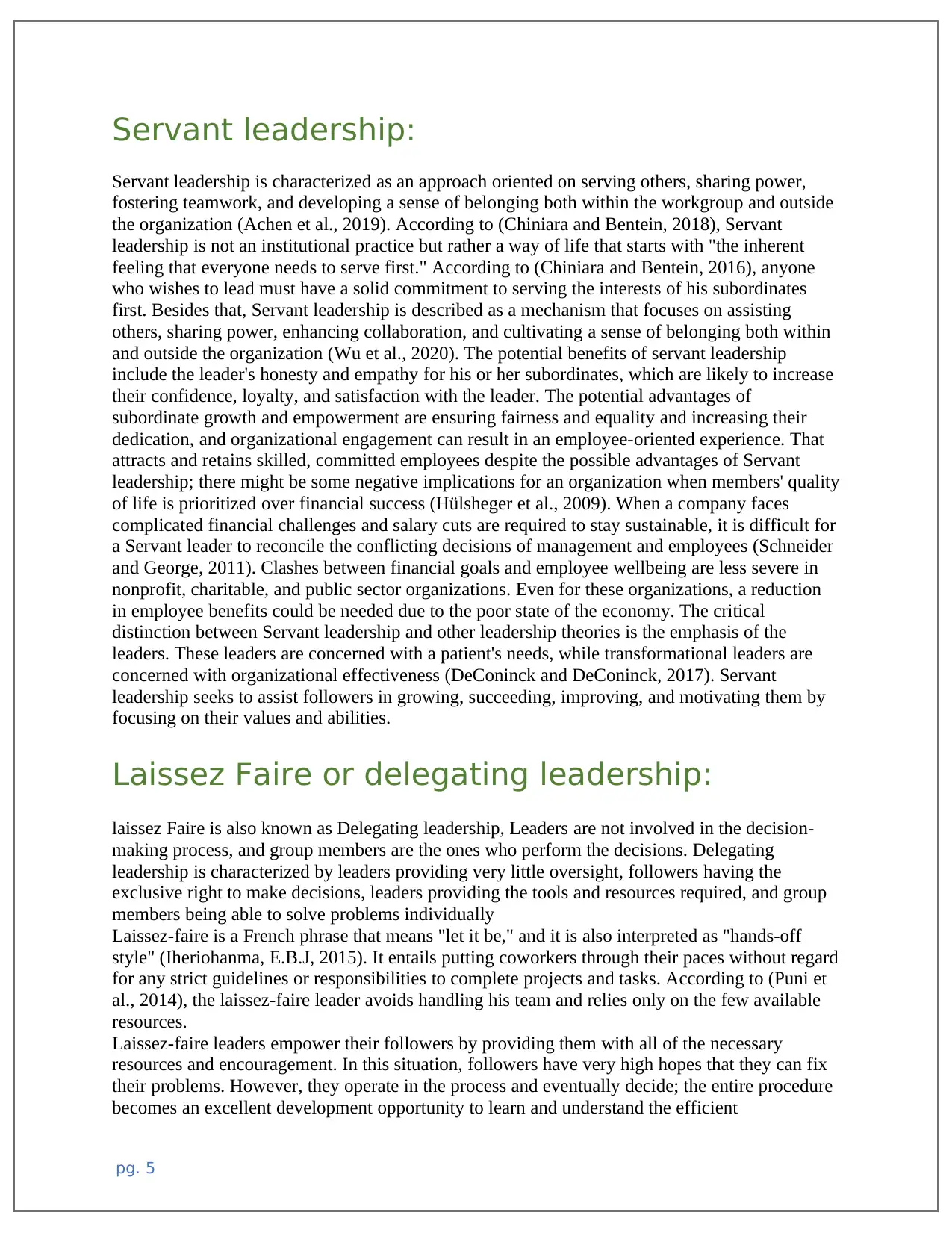
Servant leadership:
Servant leadership is characterized as an approach oriented on serving others, sharing power,
fostering teamwork, and developing a sense of belonging both within the workgroup and outside
the organization (Achen et al., 2019). According to (Chiniara and Bentein, 2018), Servant
leadership is not an institutional practice but rather a way of life that starts with "the inherent
feeling that everyone needs to serve first." According to (Chiniara and Bentein, 2016), anyone
who wishes to lead must have a solid commitment to serving the interests of his subordinates
first. Besides that, Servant leadership is described as a mechanism that focuses on assisting
others, sharing power, enhancing collaboration, and cultivating a sense of belonging both within
and outside the organization (Wu et al., 2020). The potential benefits of servant leadership
include the leader's honesty and empathy for his or her subordinates, which are likely to increase
their confidence, loyalty, and satisfaction with the leader. The potential advantages of
subordinate growth and empowerment are ensuring fairness and equality and increasing their
dedication, and organizational engagement can result in an employee-oriented experience. That
attracts and retains skilled, committed employees despite the possible advantages of Servant
leadership; there might be some negative implications for an organization when members' quality
of life is prioritized over financial success (Hülsheger et al., 2009). When a company faces
complicated financial challenges and salary cuts are required to stay sustainable, it is difficult for
a Servant leader to reconcile the conflicting decisions of management and employees (Schneider
and George, 2011). Clashes between financial goals and employee wellbeing are less severe in
nonprofit, charitable, and public sector organizations. Even for these organizations, a reduction
in employee benefits could be needed due to the poor state of the economy. The critical
distinction between Servant leadership and other leadership theories is the emphasis of the
leaders. These leaders are concerned with a patient's needs, while transformational leaders are
concerned with organizational effectiveness (DeConinck and DeConinck, 2017). Servant
leadership seeks to assist followers in growing, succeeding, improving, and motivating them by
focusing on their values and abilities.
Laissez Faire or delegating leadership:
laissez Faire is also known as Delegating leadership, Leaders are not involved in the decision-
making process, and group members are the ones who perform the decisions. Delegating
leadership is characterized by leaders providing very little oversight, followers having the
exclusive right to make decisions, leaders providing the tools and resources required, and group
members being able to solve problems individually
Laissez-faire is a French phrase that means "let it be," and it is also interpreted as "hands-off
style" (Iheriohanma, E.B.J, 2015). It entails putting coworkers through their paces without regard
for any strict guidelines or responsibilities to complete projects and tasks. According to (Puni et
al., 2014), the laissez-faire leader avoids handling his team and relies only on the few available
resources.
Laissez-faire leaders empower their followers by providing them with all of the necessary
resources and encouragement. In this situation, followers have very high hopes that they can fix
their problems. However, they operate in the process and eventually decide; the entire procedure
becomes an excellent development opportunity to learn and understand the efficient
pg. 5
Servant leadership is characterized as an approach oriented on serving others, sharing power,
fostering teamwork, and developing a sense of belonging both within the workgroup and outside
the organization (Achen et al., 2019). According to (Chiniara and Bentein, 2018), Servant
leadership is not an institutional practice but rather a way of life that starts with "the inherent
feeling that everyone needs to serve first." According to (Chiniara and Bentein, 2016), anyone
who wishes to lead must have a solid commitment to serving the interests of his subordinates
first. Besides that, Servant leadership is described as a mechanism that focuses on assisting
others, sharing power, enhancing collaboration, and cultivating a sense of belonging both within
and outside the organization (Wu et al., 2020). The potential benefits of servant leadership
include the leader's honesty and empathy for his or her subordinates, which are likely to increase
their confidence, loyalty, and satisfaction with the leader. The potential advantages of
subordinate growth and empowerment are ensuring fairness and equality and increasing their
dedication, and organizational engagement can result in an employee-oriented experience. That
attracts and retains skilled, committed employees despite the possible advantages of Servant
leadership; there might be some negative implications for an organization when members' quality
of life is prioritized over financial success (Hülsheger et al., 2009). When a company faces
complicated financial challenges and salary cuts are required to stay sustainable, it is difficult for
a Servant leader to reconcile the conflicting decisions of management and employees (Schneider
and George, 2011). Clashes between financial goals and employee wellbeing are less severe in
nonprofit, charitable, and public sector organizations. Even for these organizations, a reduction
in employee benefits could be needed due to the poor state of the economy. The critical
distinction between Servant leadership and other leadership theories is the emphasis of the
leaders. These leaders are concerned with a patient's needs, while transformational leaders are
concerned with organizational effectiveness (DeConinck and DeConinck, 2017). Servant
leadership seeks to assist followers in growing, succeeding, improving, and motivating them by
focusing on their values and abilities.
Laissez Faire or delegating leadership:
laissez Faire is also known as Delegating leadership, Leaders are not involved in the decision-
making process, and group members are the ones who perform the decisions. Delegating
leadership is characterized by leaders providing very little oversight, followers having the
exclusive right to make decisions, leaders providing the tools and resources required, and group
members being able to solve problems individually
Laissez-faire is a French phrase that means "let it be," and it is also interpreted as "hands-off
style" (Iheriohanma, E.B.J, 2015). It entails putting coworkers through their paces without regard
for any strict guidelines or responsibilities to complete projects and tasks. According to (Puni et
al., 2014), the laissez-faire leader avoids handling his team and relies only on the few available
resources.
Laissez-faire leaders empower their followers by providing them with all of the necessary
resources and encouragement. In this situation, followers have very high hopes that they can fix
their problems. However, they operate in the process and eventually decide; the entire procedure
becomes an excellent development opportunity to learn and understand the efficient
pg. 5
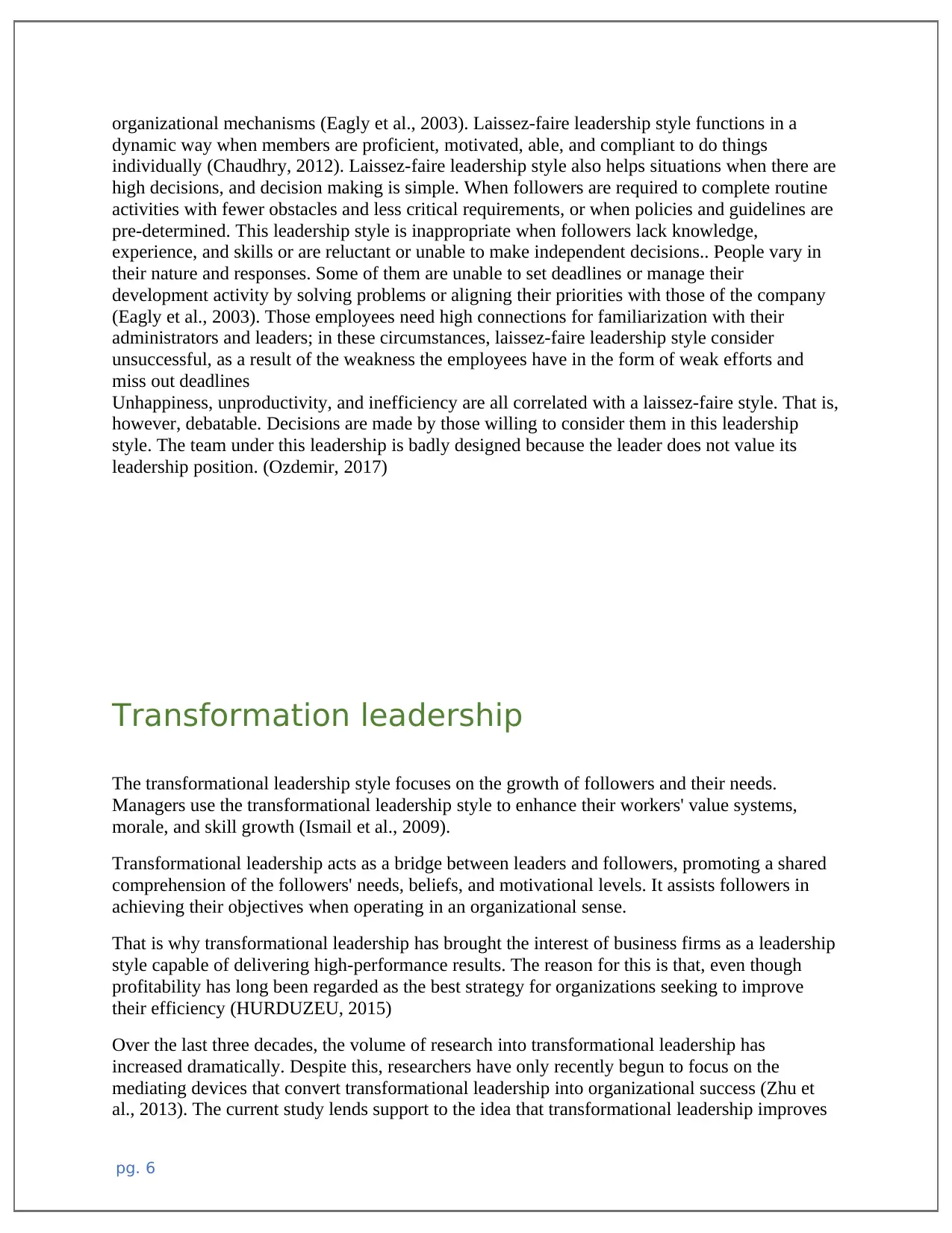
organizational mechanisms (Eagly et al., 2003). Laissez-faire leadership style functions in a
dynamic way when members are proficient, motivated, able, and compliant to do things
individually (Chaudhry, 2012). Laissez-faire leadership style also helps situations when there are
high decisions, and decision making is simple. When followers are required to complete routine
activities with fewer obstacles and less critical requirements, or when policies and guidelines are
pre-determined. This leadership style is inappropriate when followers lack knowledge,
experience, and skills or are reluctant or unable to make independent decisions.. People vary in
their nature and responses. Some of them are unable to set deadlines or manage their
development activity by solving problems or aligning their priorities with those of the company
(Eagly et al., 2003). Those employees need high connections for familiarization with their
administrators and leaders; in these circumstances, laissez-faire leadership style consider
unsuccessful, as a result of the weakness the employees have in the form of weak efforts and
miss out deadlines
Unhappiness, unproductivity, and inefficiency are all correlated with a laissez-faire style. That is,
however, debatable. Decisions are made by those willing to consider them in this leadership
style. The team under this leadership is badly designed because the leader does not value its
leadership position. (Ozdemir, 2017)
Transformation leadership
The transformational leadership style focuses on the growth of followers and their needs.
Managers use the transformational leadership style to enhance their workers' value systems,
morale, and skill growth (Ismail et al., 2009).
Transformational leadership acts as a bridge between leaders and followers, promoting a shared
comprehension of the followers' needs, beliefs, and motivational levels. It assists followers in
achieving their objectives when operating in an organizational sense.
That is why transformational leadership has brought the interest of business firms as a leadership
style capable of delivering high-performance results. The reason for this is that, even though
profitability has long been regarded as the best strategy for organizations seeking to improve
their efficiency (HURDUZEU, 2015)
Over the last three decades, the volume of research into transformational leadership has
increased dramatically. Despite this, researchers have only recently begun to focus on the
mediating devices that convert transformational leadership into organizational success (Zhu et
al., 2013). The current study lends support to the idea that transformational leadership improves
pg. 6
dynamic way when members are proficient, motivated, able, and compliant to do things
individually (Chaudhry, 2012). Laissez-faire leadership style also helps situations when there are
high decisions, and decision making is simple. When followers are required to complete routine
activities with fewer obstacles and less critical requirements, or when policies and guidelines are
pre-determined. This leadership style is inappropriate when followers lack knowledge,
experience, and skills or are reluctant or unable to make independent decisions.. People vary in
their nature and responses. Some of them are unable to set deadlines or manage their
development activity by solving problems or aligning their priorities with those of the company
(Eagly et al., 2003). Those employees need high connections for familiarization with their
administrators and leaders; in these circumstances, laissez-faire leadership style consider
unsuccessful, as a result of the weakness the employees have in the form of weak efforts and
miss out deadlines
Unhappiness, unproductivity, and inefficiency are all correlated with a laissez-faire style. That is,
however, debatable. Decisions are made by those willing to consider them in this leadership
style. The team under this leadership is badly designed because the leader does not value its
leadership position. (Ozdemir, 2017)
Transformation leadership
The transformational leadership style focuses on the growth of followers and their needs.
Managers use the transformational leadership style to enhance their workers' value systems,
morale, and skill growth (Ismail et al., 2009).
Transformational leadership acts as a bridge between leaders and followers, promoting a shared
comprehension of the followers' needs, beliefs, and motivational levels. It assists followers in
achieving their objectives when operating in an organizational sense.
That is why transformational leadership has brought the interest of business firms as a leadership
style capable of delivering high-performance results. The reason for this is that, even though
profitability has long been regarded as the best strategy for organizations seeking to improve
their efficiency (HURDUZEU, 2015)
Over the last three decades, the volume of research into transformational leadership has
increased dramatically. Despite this, researchers have only recently begun to focus on the
mediating devices that convert transformational leadership into organizational success (Zhu et
al., 2013). The current study lends support to the idea that transformational leadership improves
pg. 6
⊘ This is a preview!⊘
Do you want full access?
Subscribe today to unlock all pages.

Trusted by 1+ million students worldwide
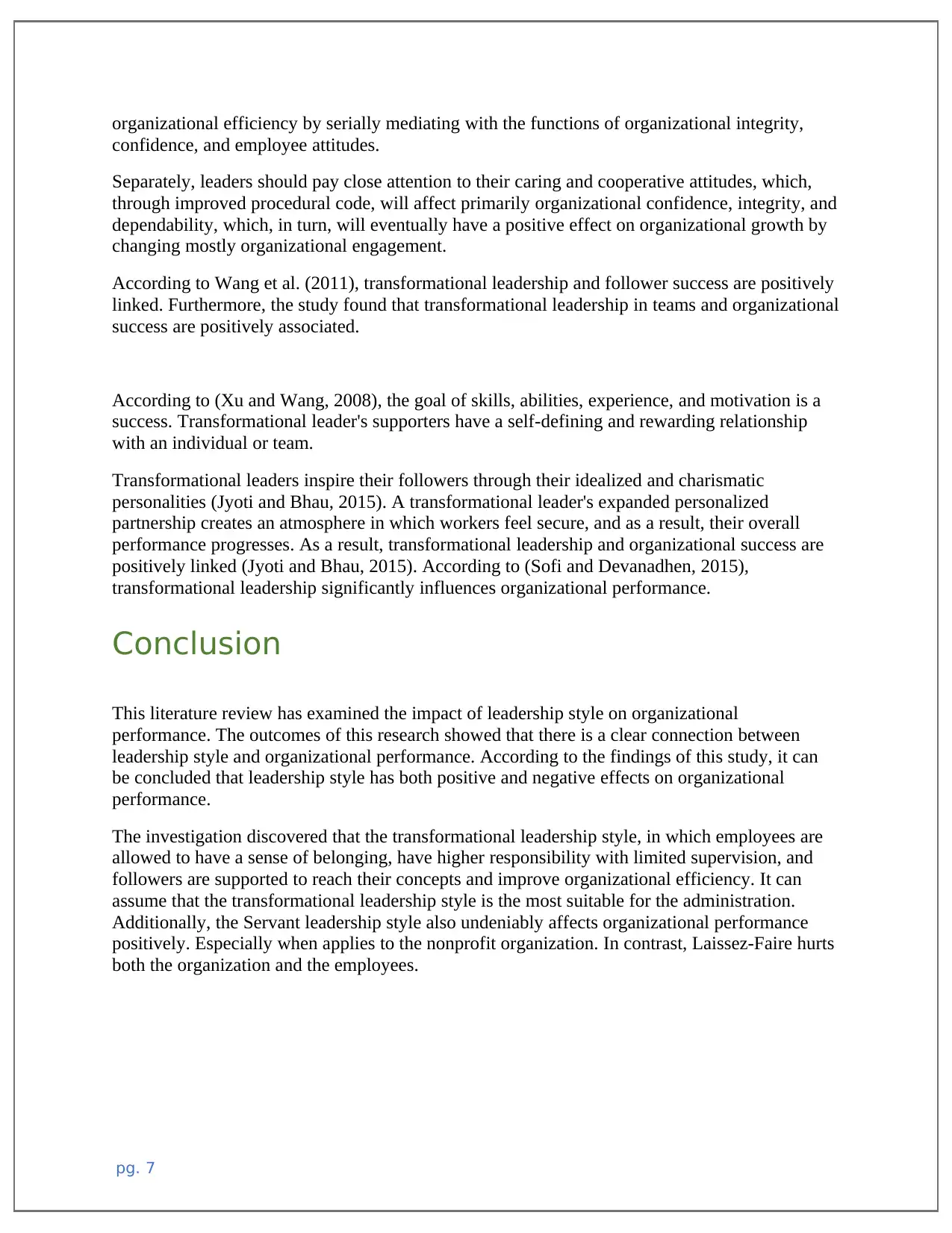
organizational efficiency by serially mediating with the functions of organizational integrity,
confidence, and employee attitudes.
Separately, leaders should pay close attention to their caring and cooperative attitudes, which,
through improved procedural code, will affect primarily organizational confidence, integrity, and
dependability, which, in turn, will eventually have a positive effect on organizational growth by
changing mostly organizational engagement.
According to Wang et al. (2011), transformational leadership and follower success are positively
linked. Furthermore, the study found that transformational leadership in teams and organizational
success are positively associated.
According to (Xu and Wang, 2008), the goal of skills, abilities, experience, and motivation is a
success. Transformational leader's supporters have a self-defining and rewarding relationship
with an individual or team.
Transformational leaders inspire their followers through their idealized and charismatic
personalities (Jyoti and Bhau, 2015). A transformational leader's expanded personalized
partnership creates an atmosphere in which workers feel secure, and as a result, their overall
performance progresses. As a result, transformational leadership and organizational success are
positively linked (Jyoti and Bhau, 2015). According to (Sofi and Devanadhen, 2015),
transformational leadership significantly influences organizational performance.
Conclusion
This literature review has examined the impact of leadership style on organizational
performance. The outcomes of this research showed that there is a clear connection between
leadership style and organizational performance. According to the findings of this study, it can
be concluded that leadership style has both positive and negative effects on organizational
performance.
The investigation discovered that the transformational leadership style, in which employees are
allowed to have a sense of belonging, have higher responsibility with limited supervision, and
followers are supported to reach their concepts and improve organizational efficiency. It can
assume that the transformational leadership style is the most suitable for the administration.
Additionally, the Servant leadership style also undeniably affects organizational performance
positively. Especially when applies to the nonprofit organization. In contrast, Laissez-Faire hurts
both the organization and the employees.
pg. 7
confidence, and employee attitudes.
Separately, leaders should pay close attention to their caring and cooperative attitudes, which,
through improved procedural code, will affect primarily organizational confidence, integrity, and
dependability, which, in turn, will eventually have a positive effect on organizational growth by
changing mostly organizational engagement.
According to Wang et al. (2011), transformational leadership and follower success are positively
linked. Furthermore, the study found that transformational leadership in teams and organizational
success are positively associated.
According to (Xu and Wang, 2008), the goal of skills, abilities, experience, and motivation is a
success. Transformational leader's supporters have a self-defining and rewarding relationship
with an individual or team.
Transformational leaders inspire their followers through their idealized and charismatic
personalities (Jyoti and Bhau, 2015). A transformational leader's expanded personalized
partnership creates an atmosphere in which workers feel secure, and as a result, their overall
performance progresses. As a result, transformational leadership and organizational success are
positively linked (Jyoti and Bhau, 2015). According to (Sofi and Devanadhen, 2015),
transformational leadership significantly influences organizational performance.
Conclusion
This literature review has examined the impact of leadership style on organizational
performance. The outcomes of this research showed that there is a clear connection between
leadership style and organizational performance. According to the findings of this study, it can
be concluded that leadership style has both positive and negative effects on organizational
performance.
The investigation discovered that the transformational leadership style, in which employees are
allowed to have a sense of belonging, have higher responsibility with limited supervision, and
followers are supported to reach their concepts and improve organizational efficiency. It can
assume that the transformational leadership style is the most suitable for the administration.
Additionally, the Servant leadership style also undeniably affects organizational performance
positively. Especially when applies to the nonprofit organization. In contrast, Laissez-Faire hurts
both the organization and the employees.
pg. 7
Paraphrase This Document
Need a fresh take? Get an instant paraphrase of this document with our AI Paraphraser
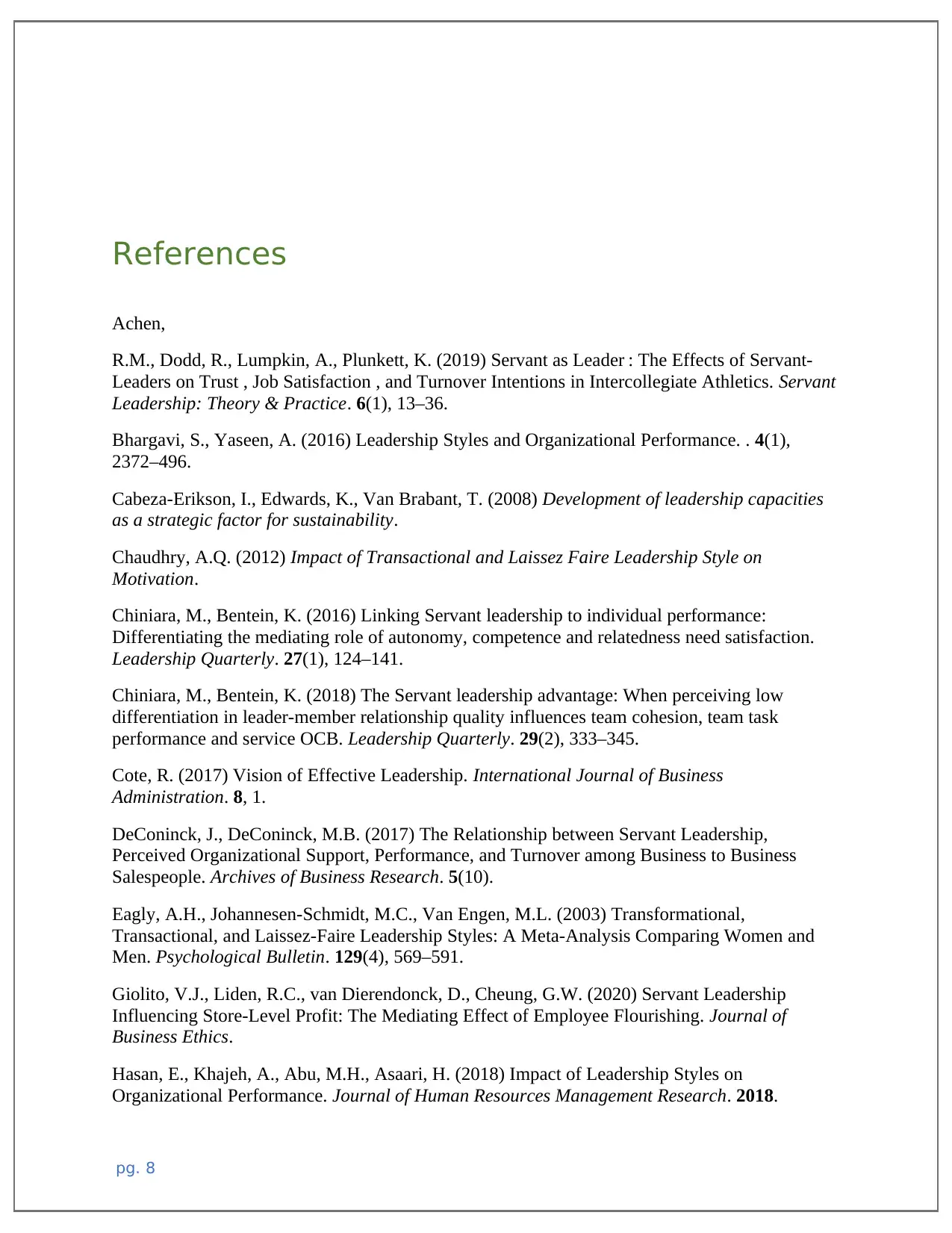
References
Achen,
R.M., Dodd, R., Lumpkin, A., Plunkett, K. (2019) Servant as Leader : The Effects of Servant-
Leaders on Trust , Job Satisfaction , and Turnover Intentions in Intercollegiate Athletics. Servant
Leadership: Theory & Practice. 6(1), 13–36.
Bhargavi, S., Yaseen, A. (2016) Leadership Styles and Organizational Performance. . 4(1),
2372–496.
Cabeza-Erikson, I., Edwards, K., Van Brabant, T. (2008) Development of leadership capacities
as a strategic factor for sustainability.
Chaudhry, A.Q. (2012) Impact of Transactional and Laissez Faire Leadership Style on
Motivation.
Chiniara, M., Bentein, K. (2016) Linking Servant leadership to individual performance:
Differentiating the mediating role of autonomy, competence and relatedness need satisfaction.
Leadership Quarterly. 27(1), 124–141.
Chiniara, M., Bentein, K. (2018) The Servant leadership advantage: When perceiving low
differentiation in leader-member relationship quality influences team cohesion, team task
performance and service OCB. Leadership Quarterly. 29(2), 333–345.
Cote, R. (2017) Vision of Effective Leadership. International Journal of Business
Administration. 8, 1.
DeConinck, J., DeConinck, M.B. (2017) The Relationship between Servant Leadership,
Perceived Organizational Support, Performance, and Turnover among Business to Business
Salespeople. Archives of Business Research. 5(10).
Eagly, A.H., Johannesen-Schmidt, M.C., Van Engen, M.L. (2003) Transformational,
Transactional, and Laissez-Faire Leadership Styles: A Meta-Analysis Comparing Women and
Men. Psychological Bulletin. 129(4), 569–591.
Giolito, V.J., Liden, R.C., van Dierendonck, D., Cheung, G.W. (2020) Servant Leadership
Influencing Store-Level Profit: The Mediating Effect of Employee Flourishing. Journal of
Business Ethics.
Hasan, E., Khajeh, A., Abu, M.H., Asaari, H. (2018) Impact of Leadership Styles on
Organizational Performance. Journal of Human Resources Management Research. 2018.
pg. 8
Achen,
R.M., Dodd, R., Lumpkin, A., Plunkett, K. (2019) Servant as Leader : The Effects of Servant-
Leaders on Trust , Job Satisfaction , and Turnover Intentions in Intercollegiate Athletics. Servant
Leadership: Theory & Practice. 6(1), 13–36.
Bhargavi, S., Yaseen, A. (2016) Leadership Styles and Organizational Performance. . 4(1),
2372–496.
Cabeza-Erikson, I., Edwards, K., Van Brabant, T. (2008) Development of leadership capacities
as a strategic factor for sustainability.
Chaudhry, A.Q. (2012) Impact of Transactional and Laissez Faire Leadership Style on
Motivation.
Chiniara, M., Bentein, K. (2016) Linking Servant leadership to individual performance:
Differentiating the mediating role of autonomy, competence and relatedness need satisfaction.
Leadership Quarterly. 27(1), 124–141.
Chiniara, M., Bentein, K. (2018) The Servant leadership advantage: When perceiving low
differentiation in leader-member relationship quality influences team cohesion, team task
performance and service OCB. Leadership Quarterly. 29(2), 333–345.
Cote, R. (2017) Vision of Effective Leadership. International Journal of Business
Administration. 8, 1.
DeConinck, J., DeConinck, M.B. (2017) The Relationship between Servant Leadership,
Perceived Organizational Support, Performance, and Turnover among Business to Business
Salespeople. Archives of Business Research. 5(10).
Eagly, A.H., Johannesen-Schmidt, M.C., Van Engen, M.L. (2003) Transformational,
Transactional, and Laissez-Faire Leadership Styles: A Meta-Analysis Comparing Women and
Men. Psychological Bulletin. 129(4), 569–591.
Giolito, V.J., Liden, R.C., van Dierendonck, D., Cheung, G.W. (2020) Servant Leadership
Influencing Store-Level Profit: The Mediating Effect of Employee Flourishing. Journal of
Business Ethics.
Hasan, E., Khajeh, A., Abu, M.H., Asaari, H. (2018) Impact of Leadership Styles on
Organizational Performance. Journal of Human Resources Management Research. 2018.
pg. 8
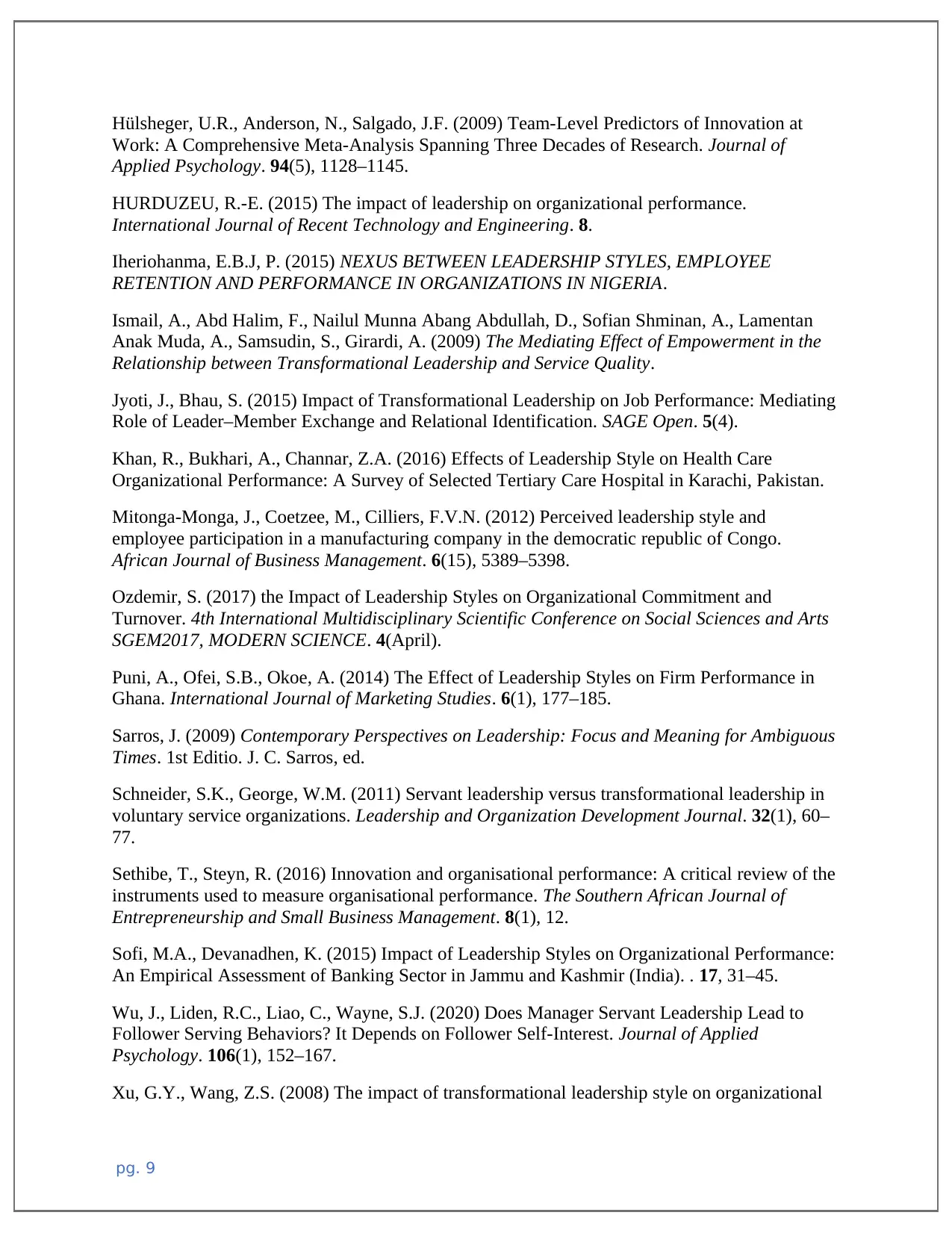
Hülsheger, U.R., Anderson, N., Salgado, J.F. (2009) Team-Level Predictors of Innovation at
Work: A Comprehensive Meta-Analysis Spanning Three Decades of Research. Journal of
Applied Psychology. 94(5), 1128–1145.
HURDUZEU, R.-E. (2015) The impact of leadership on organizational performance.
International Journal of Recent Technology and Engineering. 8.
Iheriohanma, E.B.J, P. (2015) NEXUS BETWEEN LEADERSHIP STYLES, EMPLOYEE
RETENTION AND PERFORMANCE IN ORGANIZATIONS IN NIGERIA.
Ismail, A., Abd Halim, F., Nailul Munna Abang Abdullah, D., Sofian Shminan, A., Lamentan
Anak Muda, A., Samsudin, S., Girardi, A. (2009) The Mediating Effect of Empowerment in the
Relationship between Transformational Leadership and Service Quality.
Jyoti, J., Bhau, S. (2015) Impact of Transformational Leadership on Job Performance: Mediating
Role of Leader–Member Exchange and Relational Identification. SAGE Open. 5(4).
Khan, R., Bukhari, A., Channar, Z.A. (2016) Effects of Leadership Style on Health Care
Organizational Performance: A Survey of Selected Tertiary Care Hospital in Karachi, Pakistan.
Mitonga-Monga, J., Coetzee, M., Cilliers, F.V.N. (2012) Perceived leadership style and
employee participation in a manufacturing company in the democratic republic of Congo.
African Journal of Business Management. 6(15), 5389–5398.
Ozdemir, S. (2017) the Impact of Leadership Styles on Organizational Commitment and
Turnover. 4th International Multidisciplinary Scientific Conference on Social Sciences and Arts
SGEM2017, MODERN SCIENCE. 4(April).
Puni, A., Ofei, S.B., Okoe, A. (2014) The Effect of Leadership Styles on Firm Performance in
Ghana. International Journal of Marketing Studies. 6(1), 177–185.
Sarros, J. (2009) Contemporary Perspectives on Leadership: Focus and Meaning for Ambiguous
Times. 1st Editio. J. C. Sarros, ed.
Schneider, S.K., George, W.M. (2011) Servant leadership versus transformational leadership in
voluntary service organizations. Leadership and Organization Development Journal. 32(1), 60–
77.
Sethibe, T., Steyn, R. (2016) Innovation and organisational performance: A critical review of the
instruments used to measure organisational performance. The Southern African Journal of
Entrepreneurship and Small Business Management. 8(1), 12.
Sofi, M.A., Devanadhen, K. (2015) Impact of Leadership Styles on Organizational Performance:
An Empirical Assessment of Banking Sector in Jammu and Kashmir (India). . 17, 31–45.
Wu, J., Liden, R.C., Liao, C., Wayne, S.J. (2020) Does Manager Servant Leadership Lead to
Follower Serving Behaviors? It Depends on Follower Self-Interest. Journal of Applied
Psychology. 106(1), 152–167.
Xu, G.Y., Wang, Z.S. (2008) The impact of transformational leadership style on organizational
pg. 9
Work: A Comprehensive Meta-Analysis Spanning Three Decades of Research. Journal of
Applied Psychology. 94(5), 1128–1145.
HURDUZEU, R.-E. (2015) The impact of leadership on organizational performance.
International Journal of Recent Technology and Engineering. 8.
Iheriohanma, E.B.J, P. (2015) NEXUS BETWEEN LEADERSHIP STYLES, EMPLOYEE
RETENTION AND PERFORMANCE IN ORGANIZATIONS IN NIGERIA.
Ismail, A., Abd Halim, F., Nailul Munna Abang Abdullah, D., Sofian Shminan, A., Lamentan
Anak Muda, A., Samsudin, S., Girardi, A. (2009) The Mediating Effect of Empowerment in the
Relationship between Transformational Leadership and Service Quality.
Jyoti, J., Bhau, S. (2015) Impact of Transformational Leadership on Job Performance: Mediating
Role of Leader–Member Exchange and Relational Identification. SAGE Open. 5(4).
Khan, R., Bukhari, A., Channar, Z.A. (2016) Effects of Leadership Style on Health Care
Organizational Performance: A Survey of Selected Tertiary Care Hospital in Karachi, Pakistan.
Mitonga-Monga, J., Coetzee, M., Cilliers, F.V.N. (2012) Perceived leadership style and
employee participation in a manufacturing company in the democratic republic of Congo.
African Journal of Business Management. 6(15), 5389–5398.
Ozdemir, S. (2017) the Impact of Leadership Styles on Organizational Commitment and
Turnover. 4th International Multidisciplinary Scientific Conference on Social Sciences and Arts
SGEM2017, MODERN SCIENCE. 4(April).
Puni, A., Ofei, S.B., Okoe, A. (2014) The Effect of Leadership Styles on Firm Performance in
Ghana. International Journal of Marketing Studies. 6(1), 177–185.
Sarros, J. (2009) Contemporary Perspectives on Leadership: Focus and Meaning for Ambiguous
Times. 1st Editio. J. C. Sarros, ed.
Schneider, S.K., George, W.M. (2011) Servant leadership versus transformational leadership in
voluntary service organizations. Leadership and Organization Development Journal. 32(1), 60–
77.
Sethibe, T., Steyn, R. (2016) Innovation and organisational performance: A critical review of the
instruments used to measure organisational performance. The Southern African Journal of
Entrepreneurship and Small Business Management. 8(1), 12.
Sofi, M.A., Devanadhen, K. (2015) Impact of Leadership Styles on Organizational Performance:
An Empirical Assessment of Banking Sector in Jammu and Kashmir (India). . 17, 31–45.
Wu, J., Liden, R.C., Liao, C., Wayne, S.J. (2020) Does Manager Servant Leadership Lead to
Follower Serving Behaviors? It Depends on Follower Self-Interest. Journal of Applied
Psychology. 106(1), 152–167.
Xu, G.Y., Wang, Z.S. (2008) The impact of transformational leadership style on organizational
pg. 9
⊘ This is a preview!⊘
Do you want full access?
Subscribe today to unlock all pages.

Trusted by 1+ million students worldwide
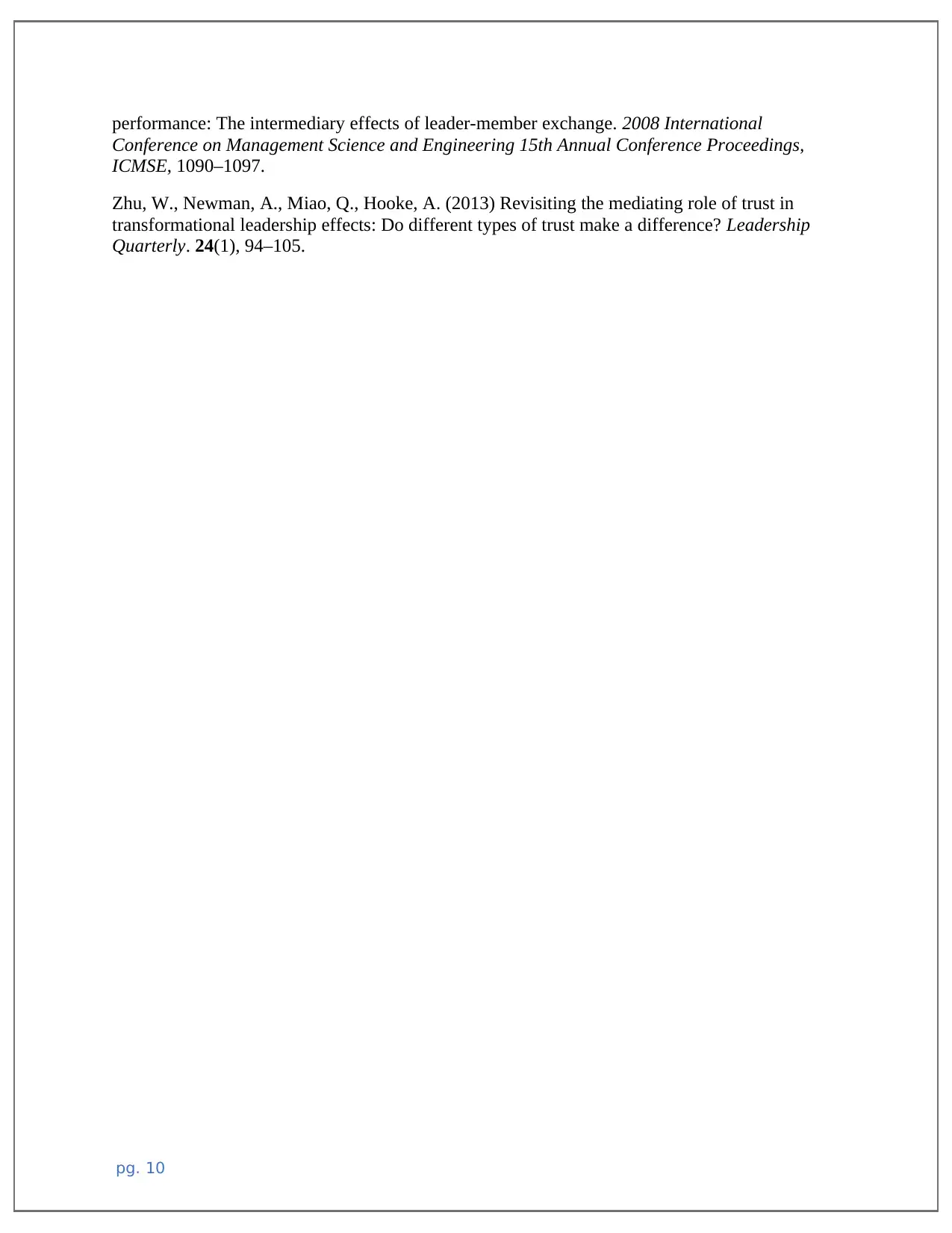
performance: The intermediary effects of leader-member exchange. 2008 International
Conference on Management Science and Engineering 15th Annual Conference Proceedings,
ICMSE, 1090–1097.
Zhu, W., Newman, A., Miao, Q., Hooke, A. (2013) Revisiting the mediating role of trust in
transformational leadership effects: Do different types of trust make a difference? Leadership
Quarterly. 24(1), 94–105.
pg. 10
Conference on Management Science and Engineering 15th Annual Conference Proceedings,
ICMSE, 1090–1097.
Zhu, W., Newman, A., Miao, Q., Hooke, A. (2013) Revisiting the mediating role of trust in
transformational leadership effects: Do different types of trust make a difference? Leadership
Quarterly. 24(1), 94–105.
pg. 10
1 out of 10
Related Documents
Your All-in-One AI-Powered Toolkit for Academic Success.
+13062052269
info@desklib.com
Available 24*7 on WhatsApp / Email
![[object Object]](/_next/static/media/star-bottom.7253800d.svg)
Unlock your academic potential
Copyright © 2020–2025 A2Z Services. All Rights Reserved. Developed and managed by ZUCOL.




